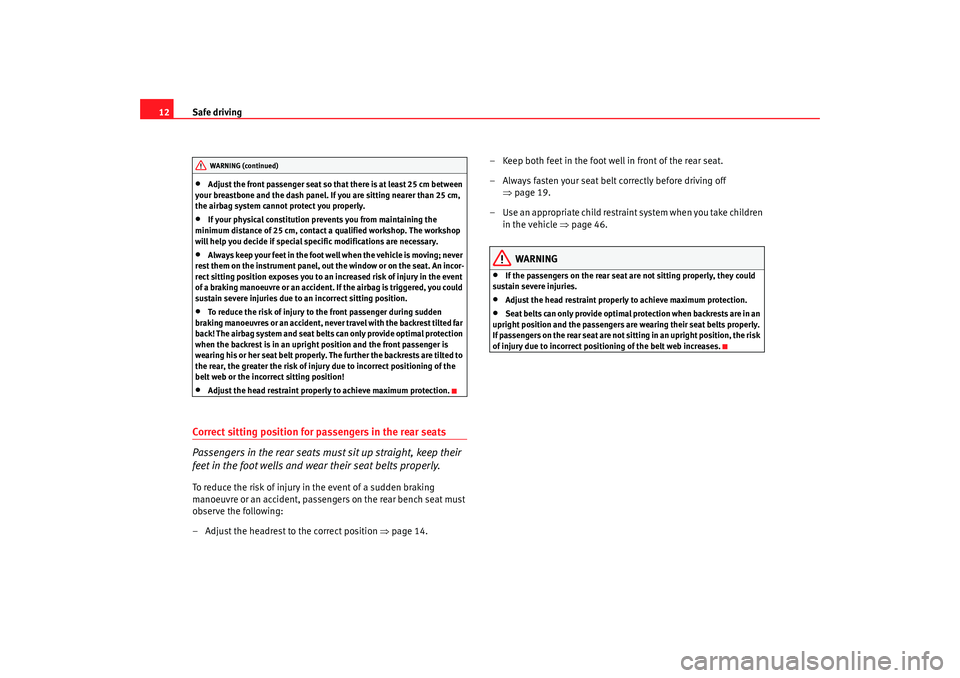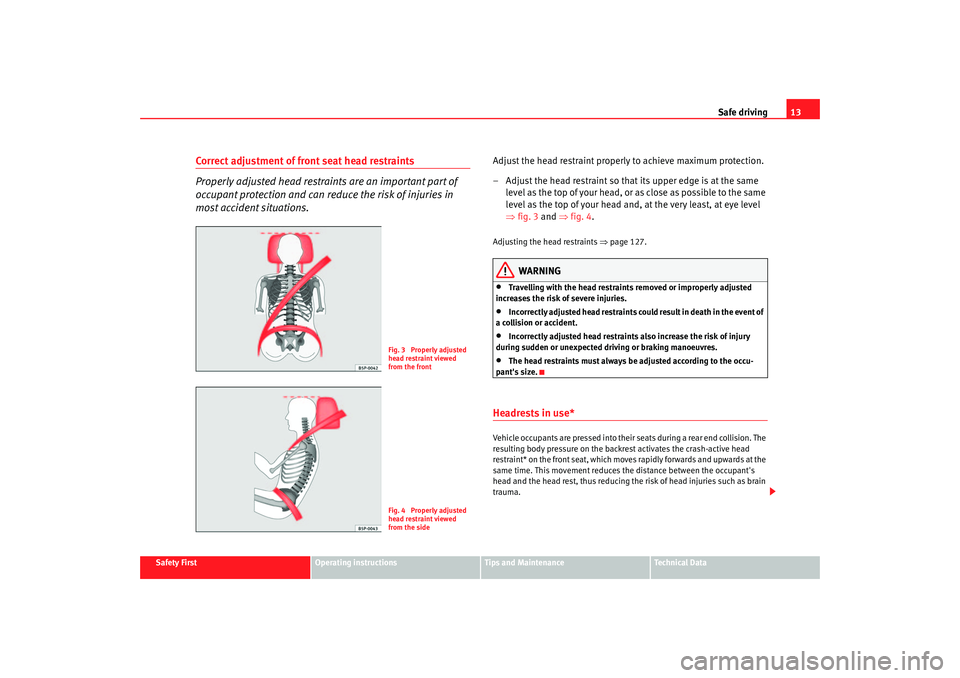headrest Seat Altea 2007 Owner's Manual
[x] Cancel search | Manufacturer: SEAT, Model Year: 2007, Model line: Altea, Model: Seat Altea 2007Pages: 302, PDF Size: 9.17 MB
Page 14 of 302

Safe driving
12•
Adjust the front passenger seat so th at there is at least 25 cm between
your breastbone and the dash panel. If you are sitting nearer than 25 cm,
the airbag system cannot protect you properly.
•
If your physical constitution prevents you from maintaining the
minimum distance of 25 cm, contact a qualified workshop. The workshop
will help you decide if special specific modifications are necessary.
•
Always keep your feet in the foot well when the vehicle is moving; never
rest them on the instrument panel, out the window or on the seat. An incor-
rect sitting position exposes you to an increased risk of injury in the event
of a braking manoeuvre or an accident. If the airbag is triggered, you could
sustain severe injuries due to an incorrect sitting position.
•
To reduce the risk of injury to the front passenger during sudden
braking manoeuvres or an accident, never travel with the backrest tilted far
back! The airbag system and seat belts can only provide optimal protection
when the backrest is in an upright position and the front passenger is
wearing his or her seat belt properly. The further the backrests are tilted to
the rear, the greater the risk of injury due to incorrect positioning of the
belt web or the incorrect sitting position!
•
Adjust the head restraint properly to achieve maximum protection.
Correct sitting position for passengers in the rear seats
Passengers in the rear seats must sit up straight, keep their
feet in the foot wells and wear their seat belts properly.To reduce the risk of injury in the event of a sudden braking
manoeuvre or an accident, passengers on the rear bench seat must
observe the following:
– Adjust the headrest to the correct position ⇒page 14. – Keep both feet in the foot well in front of the rear seat.
– Always fasten your seat belt correctly before driving off
⇒page 19.
– Use an appropriate child restraint system when you take children in the vehicle ⇒page 46.
WARNING
•
If the passengers on the rear seat are not sitting properly, they could
sustain severe injuries.
•
Adjust the head restraint properly to achieve maximum protection.
•
Seat belts can only provide optimal protection when backrests are in an
upright position and the passengers ar e wearing their seat belts properly.
If passengers on the rear seat are not sitting in an upright position, the risk
of injury due to incorrect positioning of the belt web increases.
WARNING (continued)
altea_ingles_0706.book Seite 12 Mittwoch, 30. August 2006 3:48 15
Page 15 of 302

Safe driving13
Safety First
Operating instructions
Tips and Maintenance
Te c h n i c a l D a t a
Correct adjustment of front seat head restraints
Properly adjusted head restraints are an important part of
occupant protection and can redu ce the risk of injuries in
most accident situations.
Adjust the head restraint properly to achieve maximum protection.
– Adjust the head restraint so that its upper edge is at the same
level as the top of your head, or as close as possible to the same
level as the top of your head and, at the very least, at eye level
⇒fig. 3 and ⇒ fig. 4.Adjusting the head restraints ⇒page 127.
WARNING
•
Travelling with the head restrain ts removed or improperly adjusted
increases the risk of severe injuries.
•
Incorrectly adjusted head restraints could result in death in the event of
a collision or accident.
•
Incorrectly adjusted head restraints also increase the risk of injury
during sudden or unexpected driving or braking manoeuvres.
•
The head restraints must always be adjusted according to the occu-
pant's size.
Headrests in use*Vehicle occupants are pressed into their seats during a rear end collision. The
resulting body pressure on the backrest activates the crash-active head
restraint* on the front seat, which moves rapidly forwards and upwards at the
same time. This movement reduces the distance between the occupant's
head and the head rest, thus reducing the risk of head injuries such as brain
trauma.
Fig. 3 Properly adjusted
head restraint viewed
from the frontFig. 4 Properly adjusted
head restraint viewed
from the side
altea_ingles_0706.book Seite 13 Mittwoch, 30. August 2006 3:48 15